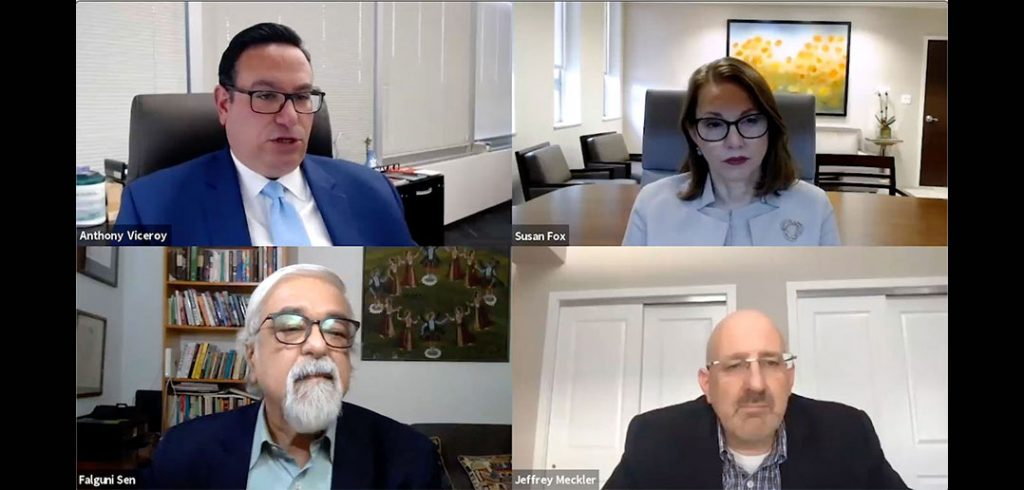“Healthcare in the Time of COVID-19” was hosted by Falguni Sen, Ph.D., a professor at the Gabelli School and the head of Fordham’s Global Healthcare Innovation Management Center. He was joined by Anthony Viceroy, CEO of Westmed Medical Group; Susan Fox, president and CEO of White Plains Hospital; and Jeffrey A. Meckler, CEO, and vice-chairman of Intec Pharma, Ltd.
Sen noted in his introduction that the same institutions that we rely on to help us survive the pandemic are now facing perils of their own, thanks to financial burdens brought on by a drop in elective surgeries, increased costs for ICU care, and physical and mental risks to staff working without enough protective gear.
“Flexibility is one of the most difficult of business challenges that we at the Gabelli School of Business have been trying to develop new theories and new practices on. On the one hand, it will require a lot of slack in resources, which can be very expensive. On the other hand, it demands creative uses of these resources, and the ability to build relationships and partnerships. It requires us to develop common goals and priorities,” he said.
Preparing for Financial Instability
Indeed, when asked for an example of a change his group made that had the biggest impact, Viceroy said conserving cash proved to be the biggest in retrospect.
“If you look at what was going on in March, overnight we lost 70% of our volume. There was also no end in sight of when things would improve,” he said.
That meant securing a line of credit from banks in February, instituting temporary furloughs, renegotiating with vendors, and taking advantage of grants offered by the state of New York. Viceroy was able to then direct resources toward securing personal protective equipment for his staff, in some cases from overseas.
‘No Playbook for This’
Fox said that one of the things that her hospital learned early on was that the normal response to crises that they’d trained for, such as active shooters or an Ebola outbreak, was insufficient.
“When started out, it felt very lonely, there was not a lot of information out there. There was no playbook for this,” she said, noting that a member of the hospital staff was infected with COVID-19 by the first patient on the East Coast, a lawyer from New Rochelle.
“Putting a command center together with a lot of people around the table; very quickly we learned that that didn’t work. There was so much coming at us so fast and furiously, so we put together a small command center of probably seven of the senior people in the hospital, and we weren’t there physically, but we were there mentally 24/7.”
Working Together to ‘Meet the Peak’
Viceroy and Fox both agreed that the emergence of telemedicine is the most obvious advance to emerge from the crisis. Fox said scaling up access to care was a lesser-known, but equally important success. When New York Governor Andrew Cuomo predicted that the state would require 140,000 beds to deal with a possible surge in infections, it was a daunting challenge, as the only 55,000 were available.
For her hospital, that meant adding 150 med-surge beds to its existing 225, an unthinkable expansion in a highly regulated industry, she said. Relaxing some of those regulations allowed them to innovate in real-time though.
“Ultimately, we didn’t have a need for 140,000 beds, but by challenging the system, increasing by 50%, and putting up field hospitals like the U.S.S Comfort and Javits Center, we put almost 100,000 beds into the system. We got darn close to needing almost every one of them,” she said.
Equally important, she said was the fact that disparate hospital systems worked together as one, in the same way, that her hospital works with 10 others in the Montefiore Network, transferring patients from overwhelmed facilities to those with room.
“Working together to create that one health system, we were able to meet those needs to the point where we were able to meet the peak, and obviously we’ve been coming down ever since. That is something for the history books,” she said.
Meckler likewise noted that the crisis has opened a door for new opportunities for the way the pharmaceutical industry operates.
“I think we have over 2,400 clinical trials ongoing worldwide and more than a dozen vaccines in mid-stage development, and this is all since that February/March time frame. That’s unprecedented,” he said.
Concern Over ‘Mindboggling’ Lack of Lessons Learned
The panelists were skeptical about the future though. Viceroy said the deep psychological impact of the pandemic on his staff is only just becoming apparent and is likely to still be a challenge should a second wave of infections take place in the fall.
Fox said it was mind-boggling that states such as Texas and Florida did not take to heart the lessons of the New York area and are now experiencing surges of infections and deaths after opening their economies prematurely.
“I’m disturbed by the lives that are going to be lost for no good reason when we can share these best practices. We had these experiences, we have these facts,” she said.
“Everyone did what they had to do, and now we’re sitting here bracing for that second wave, because a lot of people go to North Carolina and Florida in the summer, and we’re already seeing examples where our numbers are going up. Whether it’s our economies, our staff or our resources, we’re all in recovery planning now, and to go backward would be devastating.”


